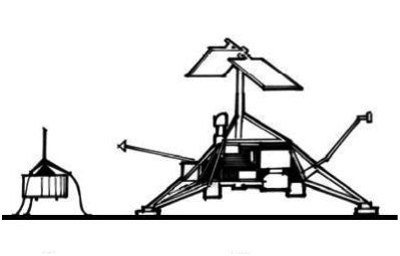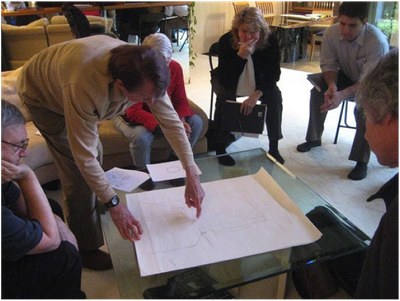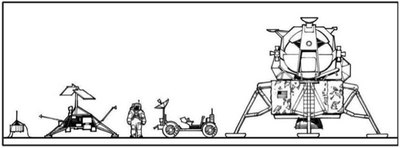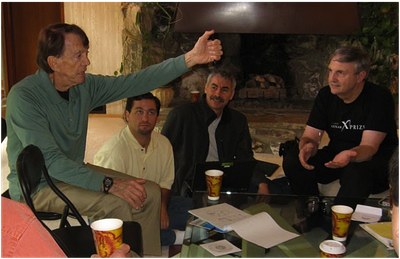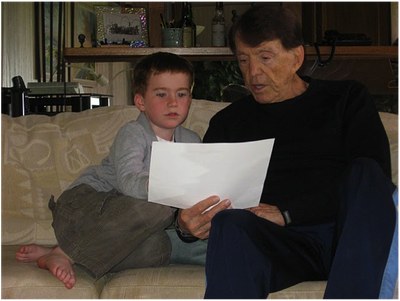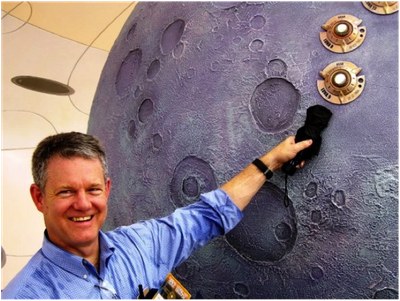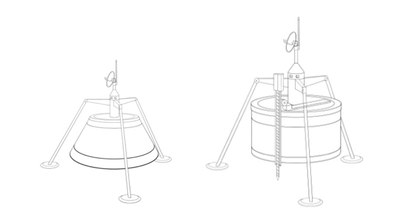Spinning for the prize<< page 1: a novel lander concept The Spirit of Southern CaliforniaIn a nod to Charles Lindbergh and the Orteig Prize, which motivated his pioneering flight across the Atlantic and decades later also inspired the formation of the X PRIZE, the team named the proposed GLXP lunar lander The Spirit of Southern California.
With various “going public” deadlines looming in mid-February, the team summarized the then-current lander mission and system design for a required posting at the GLXP website and hard-copy handouts planned for the Google HQ event. (This summary still appears at the SCSG’s team website; see the previous link to the team bios.) The baseline design at that time involved a SpaceX Falcon 1e launch, two ATK-supplied solid rocket motor kick stages (a STAR 30 and STAR 17), and an all-bipropellant liquid propulsion system on the lander itself.
The team announcement event at Google on February 21st went well, with ten teams showing a public face. Each team had a spokesperson who summarized the team and their conceptual approach to winning the prize. After this event it was clear to the SCSG team (and from what we heard later, several other teams) that the SCSG entry was a strong contender, as measured by the aggregate experience brought to the table by the individual team members, relatively mature end-to-end mission and spacecraft design6, relative simplicity of the lander concept and good sense for how the mission would be conducted operationally. The spinning lander design fielded by SCSG was unique, and so similar to what the team’s members had designed, built, launched, and operated before (hundreds of times) that as a team we had a good feel for what the end-to-end mission effort would cost, especially after getting fresh pricing data from most key suppliers. The total mission cost—for everything—was announced in a team blog post a couple of weeks after the Google event: $20 million, and about two years of schedule.
Design evolutionThe mission and system design at the time of the Google event was pretty good, but improved Falcon 1e launch performance estimates provided by SpaceX in April 2008, subsequently combined with very clever systems engineering by the SCSG team, the lander evolved to an even simpler and more elegant design by the end of May 2008.
During this time, a few additional team members came onboard, including a very interested and enthusiastic six-year-old boy referred to us by the X PRIZE Foundation (at that time also based in Santa Monica). He was an instant hit with the team and, with his mother’s permission, anointed team “mascot.”
Briefly, this was the final SCSG plan for winning the prize: A Falcon 1e launch placed the all-bipropropellant lander spacecraft with an attached ATK-supplied STAR 30 solid-motor kick stage into a 200-kilometer altitude Earth orbit. The lander’s spinning section included the solar arrays; biprop propulsion system; Sun and Moon sensors for attitude determination; a single, relatively simple landing radar; telemetry and communication transmitters; a command receiver; antennas; and a control processor. The despun section contained the landing gear, structural closeouts, and a microwave-transparent mast that surrounded the antennas and supported a separately rotatable camera assembly at the top. After the STAR 30 translunar injection burn, the approximately 240-kilogram lander—about 50 kilograms of dry mass and the rest bipropellants, providing an ~80% propellant mass fraction allowing for more than 4.5 kilometers/second delta-V capability—spun at 100 rpm in ecliptic normal attitude during its 90-hour cruise to the Moon, targeting a landing shortly after local lunar sunrise near 70 degrees W, 0 degrees N. The landing site chosen by Rosen resulted in a nearly vertical approach angle, requiring a negligible change in spin-axis attitude during the descent. This choice of landing site also permitted the use of the transfer orbit communications antenna system for lunar operations. (In an elegant blending of old and new, this antenna design was identical that used for Syncom in the early 1960s.)
The GLXP rules offer a bonus prize of $1 million for any team which can also image an existing artifact on the Moon with their lander. I was curious whether anything of interest might be near our intended landing site, and discovered after a quick peek at a National Geographic map of the Moon that the very first lunar lander, the USSR’s Luna 9, also landed at this location, for pretty much the same reasons Rosen independently employed to justify the SCSG team’s choice. Great minds think alike…
Orbit corrections during cruise consumed about 20 kilograms of bipropellant. At a lunar altitude of several hundred kilometers, with an approach speed of approximately 2.5 kilometers/second, the now ~220-kilogram lander began its descent phase using its large axial thruster for braking and small (pulsed) axial thrusters for attitude control. The landing radar, aimed 20 degrees away from the spin axis, measured altitude and vector velocity relative to the Moon, starting at an altitude of about 50 kilometers. Horizontal velocity errors were driven to zero by pulsing the radial thrusters. The axial thrusters, through an appropriate descent velocity-versus-altitude profile, controlled the lander to a soft landing. At about 1 meter above the surface, the thrusters were turned off and the ensuing free fall was stabilized by the inherent gyro stiffness of the spacecraft and cushioned by the flexible landing legs. After a nominal landing, at least 30 kilograms of bipropellant remained for hopping, enabling a potential hopping range of about 5 kilometers (vs. the GLXP-required 0.5 kilometers). To meet the all GLXP Mooncast requirements, a HD camera system designed from ruggedized commercially available components was mounted at the top of the antenna mast. It enabled views looking downward to the top of the lander and nearby lunar surface as well as outward to the distant lunar horizon. The camera itself stared in a generally upward orientation at a tiltable mirror that provided the required elevation viewing range. The pan requirement was met by rotating the camera/mirror assembly around the mast axis. For comparison, the resulting SCSG lander-hopper design was dramatically smaller and lighter (about one sixth the mass) than the Surveyor landers launched over forty years before. And it could hop like a lunatic jumping spider. Spinning outWith the mission and spacecraft design converged to a comfortable baseline by mid May, the SCSG team put more effort into understanding the source of supply for the various hardware elements required to execute the project: the Falcon 1e rocket; the STAR 30 kick stage; propellant tanks, thrusters, valves and lines; solar cells, electronics, and structures. Prices from preferred suppliers were solicited and received. Spare propellant tanks destined for the salvage heap were pledged (at little or no cost to the SCSG team) by Boeing Satellite Systems. An entire floor of an El Segundo office building was pledged by another aerospace firm in exchange for quarterly strategic planning meetings with Rosen. Working SCSG team members were negotiating with their “day job” firms for possible leaves of absence—at least one quit his job—while retired members were considering coming out of retirement for an active (and hopefully brief) stint on the team. Most of the team was willing to work for no charge in exchange for a share of the $20-million first-place prize. Then things unraveled, and in a hurry. A GLXP “summit” was held in Strasbourg, France on May 20th. SCSG sent Castleman, who reported on the trip a few days later on the team’s blog, titling her post as “Some serious thinking at the Southern California Selene Group.” Per her blog post:
As it turns out, neither Rosen nor his like-minded wife have ever been advocates or supporters of human space travel or visions of expansive human activity in space—government or commercial. After another fretful day of considering their fundamental disconnect with the GLXP backers on visions of the future in space, other issues specific to the GLXP competition, rumors of the phase-out of the Falcon 1e rocket and the obvious “big elephant in the room” for all teams—funding—Castleman posted a final farewell on the SCSG blog. Harold and Deborah were no longer having fun. The team was OUT. AftermathThe SCSG team disbanded more quickly that it formed. But the spinning lander idea did not fade away as an asterisk in some space-history book. Realizing the uniqueness of the concept, in early 2008 Rosen filed a provisional patent for the spinning lander, starting a one-year fuse until a formal patent application was due. Symmes and I expressed interest in promoting the concept to other potential partners and customers—none related to the GLXP competition—and Rosen gladly and generously offered his support. Just before the one-year deadline a formal and very comprehensive patent application prepared by me and Rosen’s patent attorney was filed in the U.S. and internationally, with Rosen named as the inventor. The summary of the invention reads as follows:
A year later, in early 2010, Rosen assigned the still-pending patent over to Ecliptic Enterprises Corporation, noting that “I have already commercialized space technology that created hundreds of billions of dollars of value in the marketplace, and don’t need to do that again!”
As the new carrier of the spinning lander torch, in summer 2011 I started exposing the concept to an expanded audience of potential customers and users, first at the Low-Cost Planetary Missions Conference held at Applied Physics Lab in Maryland, with a very positive reception from several firms, labs and teams.7 I had put a bit more substance to the concept by suggesting some design variants which would be applicable to landing on other solar system bodies, or to simply do more at the Earth’s Moon than win a prize. Subsequent public and private presentations have been made and discussions held (including one funded assessment contract), and more are planned.
After a couple of rounds of modifications to the application, in January 2013 the US Patent and Trademark Office granted patent number 8,353,481 for a spin-stablized lander to Harold A. Rosen.8 Multiple international patents are still pending. Meanwhile, at age 87 Harold Rosen is still consulting, still swinging rings at Santa Monica Beach, and still innovating. And several members of the SCSG team stand ready to give Rosen’s new lander concept a spin. References1 For a summary of the Syncom program, see http://en.wikipedia.org/wiki/Syncom. 2 For more on Rosen, see http://en.wikipedia.org/wiki/Harold_Rosen_(electrical_engineer). 3 For background on the Google Lunar X PRIZE, see http://en.wikipedia.org/wiki/Google_Lunar_X_Prize. 4 http://www.googlelunarxprize.org/teams/scsg. Links to Castleman’s blog posts are also on this website page. 5 This is the home-made video produced by Rosen that elegantly introduced the core idea underlying his new lander concept: http://www.youtube.com/watch?v=o1lMpWlHgvo. 6 http://www.youtube.com/watch?v=h6_umNrO_s8. This animation sequence was first shown at the SCSG team’s public announcement at Google in February 2008. It depicts SCSG’s spinning lander concept and end-to-end mission sequence for winning the GLXP. It was produced by Josh Rosen (Rosen’s grandson) and his friend Max Johnson, both high school students on the team. 7 2011 Jun 21–24, R. Ridenoure and R. Symmes: Spinning Landers: A New Spacecraft System Architecture for Solar System Exploration; presented at Low-Cost Planetary Missions Conference #9, held at Applied Physics Laboratory, Laurel, MD. 8 See the patent details at http://tinyurl.com/me2br6e. Home |
|
